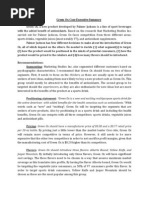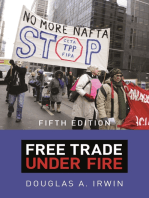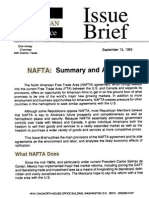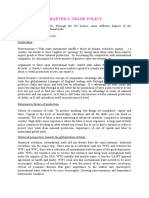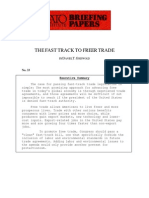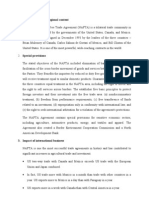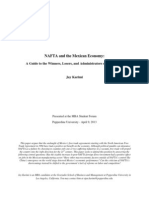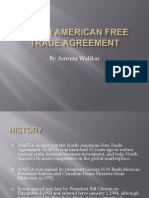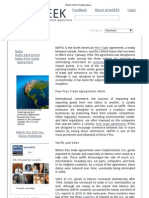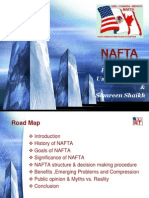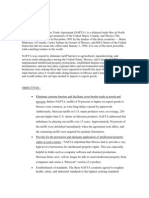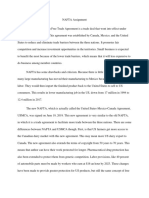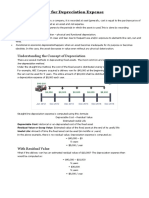Nafta App
Nafta App
Uploaded by
api-250296242Copyright:
Available Formats
Nafta App
Nafta App
Uploaded by
api-250296242Original Title
Copyright
Available Formats
Share this document
Did you find this document useful?
Is this content inappropriate?
Copyright:
Available Formats
Nafta App
Nafta App
Uploaded by
api-250296242Copyright:
Available Formats
Mullins - 1
John Tyler Mullins Dr. Samir Saliba 25 November 2012
NAFTA: The Reality of a Free Trade Agreement
The North American Free Trade Agreement (NAFTA) was signed into law in 1992, between Canada, the United States, and Mexico. Free trade agreements are created for the purpose of allowing goods and services to flow across national borders without the penalties of high tariffs. Tariffs are imposed upon another countrys exports to raise their price in order to keep that country from dumping cheaper made products into the market and displacing domestically made products of the same type. NAFTA was meant to reduce trading costs, increase each member countries investments into the other two members economies, and position each member to be more competitive on the international market. All elements of NAFTA were not meant to become effective at the signing. Several parts were set to faze in over a fifteen year time period. The fifteen year threshold has passed now and full implementation is in effect, with the exception of the long haul trucking clause which was supposed to open up the borders to each countries trucking industry. This part has been permanently suspended by the U. S. Congress, until the time they decide to relent and allow it to go into effect. In this paper, I will discuss the major impacts of NAFTA on the U.S. economy, and also, how Mexico and Canada have been affected. I will also show how NAFTA should not be repealed, but how some minor changes can make the agreement more suitable to each of the member countries and help to position their trade relations to be more competitive on the international market.
Mullins - 2
The premise of free trade is that an increase in the flow of goods and services across national boundaries will improve the average standard of living of people on both sides of the border(Kehoe, p. 2). The hope is that industries of each participating country would specialize in those products they can provide more efficiently than the other countries. This can bring about gains in production processes, make for better competition internationally, and also raise the bar to push for even greater advances in technology. On the other hand, some industries will suffer from the competition and be forced to close. Employees will be forced to move into other jobs or be unemployed. NAFTA was originally conceived and formed for several reasons, the most of which are: 1. To grant the signatories Most Favored Nation status. 2. To eliminate barriers to trade and facilitate the cross-border movement of goods and services. 3. To promote conditions of fair competition. 4. To increase investment opportunities. 5. To provide protection and enforcement of intellectual property rights. 6. To create procedures for the resolution of trade disputes. 7. To establish a framework for further trilateral, regional and multilateral cooperation to expand NAFTAs benefits. (Amadeo, History of NAFTA) The agreement was signed into order by President George H. W. Bush, Mexican President Salinas, and Canadian Prime Minister Brian Mulroney in 1992. It was ratified by the legislatures of the three countries in 1993. It was signed into law by President Bill Clinton on December 8,
Mullins - 3
1993 and entered force on January 1, 1994 (Amadeo, History of NAFTA). It became a priority under the administration of President Clinton and was one of his most recognized successes. You have to look further back in history for the beginnings of NAFTA, though. The actual concept began under President Ronald Reagan. He began an effort to have Congress pass the Trade and Tariff Act which would give the President the authority to negotiate free trade agreements and only allow Congress the right to approve or deny them. This opened the door for the Canada U. S. Free Trade Agreement which was signed into law on October 4, 1987. NAFTA was just an extension of this agreement. With the creation of NAFTA, the worlds largest trilateral trade agreement was born. The three member countries had a combined consumer market population of 370 million people with a combined Gross Domestic Product (GDP) of over $6 trillion dollars (Kehoe, p. 3). GDP is the monetary value of all the finished goods and services produced within a countrys borders during a period of time, usually measured on a yearly basis. The GDP is a commonly used measurement of a countrys economic health. This large GDP surpassed the European Unions total GDP by a considerable margin. The agreement combined Mexicos developing economy with two first-world economies, elevating Mexico to a status they could never have imagined alone. Some feared that Mexico was not ready for being thrust into this position. For the U.S., the opening of Mexicos border was portrayed as a great victory. Mexico had been applying tariffs to U. S. trade goods that were up to 250% higher than U. S. tariffs on their own goods (Amadeo, History of NAFTA). Canada, on the other hand, trades very little with Mexico, so the agreement had little effect upon their relations. Over the years, NAFTA has been a key issue with many U. S. Presidents and also a hot topic in Presidential debates. Arguments have raged on whether the agreement has been good, or bad, for the U. S. economy. Out of these debates,
Mullins - 4
three of the most talked about issues of NAFTA are worker displacement, job loss, and the shutting down of our factories. Worker displacement is a condition that develops whenever a persons current job is eliminated and he, or she, is forced to re-locate geographically, to remain employed, or is forced to acquire new skills to shift into a new line of work for the company. Sometimes this new skill re-training is at the workers personal expense and there may be some period of time when they will not be employed and are not being paid. Also, the new line of work they may be forced to enter is, more often than not, at a lower pay scale and with fewer benefits than the previous job they held. A person that suffers from job loss has had their job totally eliminated and there is no alternative employment available from the company where they had been working. This usually occurs in an industry that is more labor-intensive and the company would have trouble competing with Mexicos low wage work force. The person is then forced to begin searching for a different job in a market that is already saturated with unemployed workers and new people are being added each day. Competition for the few jobs available is tough and, once again, the person is usually forced into a much lower paying job with fewer benefits. Industry shut-down occurs when companies are unable to compete with cheap imports that are being produced in other countries where they have much lower wages and low operating costs. When this happens, the entire labor force working at the plant will lose their job. Sometimes, the company may decide to re-locate their plant outside the U. S. borders, to take advantage of the lower cost structure the new country enjoys. There are many factors that go into the decision to move outside the U. S. Low wage rates, health care costs, lower
Mullins - 5
environmental standards, and large work forces are just a few of them (Kehoe, p. 5). Companies that do not re-locate, or that do not shut down entirely, are forced to slash operating costs in order to compete. This, most often, leads to lower wage and benefit packages and an over-all lower standard of living for their employees. The labor force in the manufacturing industry in the United States has received the most casualties, over the last several years. In total, 682,900 jobs (Amadeo, Disadvantages of NAFTA) were lost between 1994 and 2010. Of these, 80% were in manufacturing, primarily in the industries of motor vehicles, textiles, computers and electronic parts, and electrical appliances. This scale of job loss was not a problem felt only in the U. S., though. In Mexico, 1.3 million farm jobs (Amadeo, Disadvantages of NAFTA) were lost to imported corn and other grains coming south from the United States. Small rural farmers, with 10 hectare plots or less, could not compete with imported agriculture goods once the tariffs were removed. The reduction in tariffs between the three member nations has greatly affected trade between each of them. NAFTA was predicted to greatly boost the U. S. trade with Mexico and its huge consumer market, but evidence shows we now have a $97.2 billion dollar (Scott, p. 5) deficit with Mexico. Before the signing in 1994, the U. S. had a, small but positive, $1.6 billion dollar trade surplus with Mexico. Some would say that NAFTA has clearly taken U.S. trade in the wrong direction. But were there other factors at work as well? Mexico, on the other hand, has become a much larger exporter of goods, to the U. S. and also, internationally. This new openness has been a blessing to most people in Mexico, bringing better paying jobs to most sectors of their economy. The boost in their standard of living has also brought about an increase in the amount of goods they import, and consume, from other
Mullins - 6
countries. Their actual trade with other countries operates at a deficit, though, except for the U.S. They are importing more goods than they export to the rest of the world. Canada has also benefited from the open trade agreement, but not as much as from their openness to global trade and investment. Canada has always had a more open view of global trade than their other two members to the south. Currently, the main concern of Canadians with NAFTA is the amount of fresh water beginning to be exported to the U. S. The U. S. already imports more oil and natural gas from Canada, than anywhere else in the world. NAFTA imposes restraints upon Canada to keep them from placing limits on the amount of energy the U.S. imports. Because of this, they are afraid of losing control of the amount of the fresh water supply they will be required to export to the U.S., also. By taking a closer in depth look at each of the three member nations, I will examine who the real winners or losers have been. I will first examine how the economies of each nation has been affected and then discuss how each nation views their trade relations with the U. S., and with the rest of the world. I will also discuss whether each nation would benefit from a renegotiation of the agreement, or be better off leaving it alone.
The United States
The U. S. has probably suffered the most loss because of NAFTA. With predictions of huge export markets waiting to the south, the U. S. pushed ahead to lead negotiations for the agreement. We benefited from a small trade surplus prior to 1994, but this soon escalated into a large deficit by 2010, rising at a rate of 14.6% per year (Scott, p. 5). This trade deficit has been said by some to have led directly to the loss of 682,900 jobs in the U. S. since 1994. The deficit developed because the trade agreement removed U. S. tariffs on Mexican goods. A tremendous
Mullins - 7
amount of foreign investments poured into Mexico, starting up industries just to take advantage of the American import market. The U. S. also developed large trade deficits with Canada, until 2004, when the imbalance slowed due to the escalating value of the Canadian dollar compared against the U. S. dollar. The current deficit, in non-oil products, is slightly less than $1 billion dollars. Trade with Canada is no longer displacing American jobs. Not everything concerning NAFTA has been detrimental, though. The competition in trade goods has resulted in American factories that are technologically up to date, efficient, and productive. Trade between the U. S., Mexico, and Canada grew from $297 billion in 1993, to $1.6 trillion in 2009 (Amadeo, Advantages of NAFTA). Exports from the U. S. to both Mexico and Canada grew from $142 billion, to $397 billion over this time period. In return, imports from both grew from $151 billion to $438 billion. Even though we moved into a trade deficit situation, our total amount of trade increased significantly.
Mexico
Most people in Mexico deem NAFTA as the blessing in the sky, because it has caused to create more and better paying jobs in most parts of the country, in which for years most residents lived on scrapping farm produce for their daily consumption(Kapenda, p. 2). Mexico probably has seen a greater benefit from NAFTA than the U. S. or Canada. NAFTA transformed and modernized Mexicos economy. The boost in manufacturing has helped to diversify their exports away from primarily oil, to become one of the largest exporting countries in the world. Mexicos exports to the U. S. have grown from $60 billion in 1993 to $280 billion in 2008
Mullins - 8
(Teslik, p. 3). The agreement has also brought down the cost of goods for Mexican consumers, increasing their purchasing power. Foreign Direct Investment (FDI) has increased dramatically in Mexico since the agreement. NAFTA reduced the risk of doing business in Mexico and improved the profitability. After the agreement went into effect, there was a flood of foreign investment into the country to take advantage of the tariff free U. S. market. Adverse effects to Mexico have been few, but probably the worse has been to the small farm industry. Importing cheap corn and grain from the U. S. has all but eliminated the small farmer from the Mexican landscape. They have lost a total of 1.3 million farm jobs throughout the country. Also, wages have remained low in Mexicos new industrial sector. This fact has not helped to decrease the amount of immigrants leaving for the U. S. and its higher paying job market. The weakening economy in the U. S. also hurts Mexico. An economy in recession doesnt consume as many goods and with the U. S. being the largest recipient of Mexican products, the Mexican economy will bear some of the brunt of the U. S. recession. The Mexican economy was also impacted and complicated by the peso crisis(Burfisher, p. 133). The peso crisis began in 1994, soon after NAFTA was signed. Foreign investors lost confidence in the value of the peso and began to withdraw their investments. The Mexican government didnt have the capital to support their base currency, and therefore, it lost nearly 50% of its value. Free trade with the U. S., though, was a convenient solution to help end the problem much sooner than would have been possible before NAFTA.
Mullins - 9
Canada
Canada has also seen its share of success from NAFTA, but their prosperity is built upon its openness to international trade and investment (Kapenda, p. 2). Of the three members, Canada has seen the strongest gains. Not only has their economy grown faster, but their employment levels have risen and their industries have remained strong. Canada is the largest supplier of crude oil and natural gas to the United States. Through NAFTA, energy resources are shipped free of any tariffs, keeping their cost low. The Canadians hold somewhat of a grudge against the U. S. for using NAFTA to take control of their energy resources and are hoping that their fresh water resources do not follow a similar route. The U. S. has been importing ever increasing amounts of fresh water from Canada. There is a certain faction in Canada that feel NAFTA was a scam and a means for the U.S. to gain free access to their energy resources. This group feels that the U. S. have used NAFTA to their advantage by denying market access on several products which Canada would love to export more trade goods. These products are cattle, steel, and potatoes. The U. S. has the right to invoke a denial to receive imports in certain products when they begin to hurt their domestic production of these products. Another product which Canada is fighting for increased exports is lumber. The U. S. claim the industry is being subsidized by the Canadian government, allowing them to sell at a much lower rate than the U. S. logging industry. The same can be said for Canadas wheat industry. Some would say that the U. S. is trying to bring about the end of the Canadian Wheat Board, Canadas largest net earner of foreign currency (Canadian Dimension, p. 1). A movement is underway to have Canada withdraw from NAFTA, but it is not without its strong
Mullins - 10
opposition. Canadas future, some would say, would be far brighter outside of the shadow of the U. S. NAFTA was created in response to the trade agreement that binds several countries in Europe together. One of the main reasons for the formation of NAFTA was for the three member countries to better compete with the European Union. The EU owes some of its success to its not only being a free trade union, but also an area of free mobility for all European nationalities. This free movement pertains to both workers and students. Each person can live and work in any member country as long as they want, without having to have any other criteria other than just being European. The EU has also adopted a single currency for all its member nations. This greatly eases the pain of doing business across borders. Most EU members try to trade within the union. This is mainly due to the larger number of members, allowing each to specialize in their own unique products or services. A wider variety of products are available for trade, making it unnecessary to look outside of the Union for trade goods. For the NAFTA members to become more competitive, they must become much more unified in their relations with each other. They must also consider the possibility of expanding into the largely untapped market in Central and South America. By integrating the Latin American countries, a trade region could be developed that would dwarf the EU in size, but match them in the number of member nations. This diversity would also allow for the expanded NAFTA group to concentrate their trade within the group and away from outside countries, similar to the way the EU handles trade.
Mullins - 11
Needless to say, the debate concerning the success or failure of NAFTA sways back and forth, depending on to whom you listen. The issues are complicated and by the very nature of a nations economy, can be nearly impossible to understand. Leading Democratic politicians have called for changes to NAFTA and want to renegotiate the terms to include stiffer labor and environmental protection clauses. Canada would relish the chance to reopen the negotiations and try to block some of the flow of their energy resources across the border to the U. S. Mexico, on the other hand, would love to limit the flow of cheap corn and grain coming into their country from the U. S. As you can very well see, all three member nations have reasons to want to make some changes to the agreement. Whether each country can be coaxed back to the negotiation table may be a long shot though, for fear of what they may have to give up, to get what they want the most. Job displacement and wage reduction are the most common concerns of NAFTA, in the U. S. But most economists point to other factors for these shifts in the economy. Daniel T. Griswold, the director of the Center for Trade Policy Studies at the Cato Institute, has said job losses are part of a structural shift of the U. S. economy. Its a cruel illusion to say if we just go in and tinker with NAFTA there will be some kind of industrial renaissance(Teslik, p. 3). Griswold says that a shift away from a focus on heavy manufacturing and onto a focus on light manufacturing and high-end services is a natural progression of the economy. We have been losing jobs steadily, in the manufacturing industry that has been highly labor intense, as they make the shift to a more mechanized and computerized setup. Many studies have shown that NAFTA has actually had only a minimal effect upon the member nations economies. The actual effects from NAFTA can be easily confused with much more powerful factors such as long-term structural change and short-term volatility (Hornbeck,
Mullins - 12
p. CRS-6). If changes are made, they should address the areas of longer tariff reduction schedules to better allow trade-related adjustment, safeguards to protect against sudden trade shifts that displace domestic production, and the removal of agricultural subsidies. Other areas to possibly address would be labor protection policies, environmental concerns, immigration, labor educational retraining, and institutional reform (Hornbeck, p. CRS-6). These arguments for tweaking NAFTA could be totally unnecessary. Economic theory argues that bilateral trade balances are irrelevant. Only a nations aggregate trade balance matters and it is a macro-economic phenomenon, determined by the gap between a nations domestic savings and investment. The trade balance depends at least as much on what happens in the financial markets as in commodity markets(Burfisher, p. 131). As we look at our country today, compared to 1993, can we honestly say we are better off, or worse, for having NAFTA? A lot depends upon what our political positions are, as a country, when this is discussed. The Democratic Party would have us believe NAFTA must be changed or abandoned altogether. They see only job losses and wage reductions as a result of the trade deficit, but they seem un-reluctant to do anything about it. The Republican Party, on the other hand, would have us feel differently. They tout the industry is better able to compete globally, and that we have more streamlined, efficient factories that have evolved from the competition created by this trade agreement. To go along with these changes is a work force better suited to produce goods and services at a competitive advantage. The truth actually lies somewhere in the middle of these two positions. While some adjustments probably are needed, care must be taken to also address the issues of Canada and Mexico. We need to build a stronger, closer relationship where all members feel their best interests are prioritized under the agreement. Any changes to the agreement must be well thought out in advance, we dont want
Mullins - 13
to cause a situation that could bring more harm to our fragile economy during this time of recession. We also need to look to the EU for examples of what works and what does not. I, for one, feel their policy of allowing individuals to travel and work anywhere within the Union to be very interesting. We may do well to examine this and give it serious consideration. If we made it legal for Mexicans to cross the border and work in the U. S., you could eliminate several problems. Because their presence here would be legal, they could accept a job and pay taxes just like an American and would no longer have to take lower wages from employers wanting to skirt the law. This would eliminate Americans losing jobs at home to illegal aliens. Also, it would increase our tax base, because all the workers would then pay taxes instead of working for cash. It would help Americans, also, who may want to follow a job that has relocated to Mexico. They could remain a citizen of the U. S. and still vote in our countries elections, but work and pay taxes in Mexico. The other aspect of the European Union that sets them apart is their single currency. I actually feel we may not want to change our currency in the same way, though. The U. S. dollar has been a standard of money measurement for some time, and traditionally held its value at a more than consistent rate. The sacrifice it in order to create a single currency for the NAFTA group, may be too stressful to our economy. I am also sure that it would be near impossible to even think that we could talk Mexico and Canada into switching their base currency to the U. S. dollar. Changing NAFTA appears to be a political tool of late. I dont know that any politician will actually move to make the changes society seems to want made. The truth is, while NAFTA
Mullins - 14
may have hurt our economy somewhat, we are benefiting from it in other ways. We now import more oil from Canada than we do from any other country. This is keeping the cost of oil, and therefore gasoline, to a minimum since we are not paying a high tax on top of the cost of a barrel. Also, while we may be operating at a deficit with Mexico and Canada, we have increased our trade base amount significantly. This could not have been accomplished without the free trade agreement. Even with the loss of industry jobs to companies moving plants out of the country, our remaining factories are producing goods at a margin far above what they were in 1993. This alone, has led to increases in jobs in the industrial sector. The recent down turn in our economy has set this back to a negative in job creation, though. The major problem facing the U. S. and the creation of new jobs is the huge national debt that now exists. The debt has grown to more than $16 trillion dollars. This amounts to more than $51,000 for each man, woman, and child living in America. China and Japan each hold over $1 trillion of this debt in direct loans to the U. S. While this issue is not the topic of this paper, it is hard to imagine a successful attempt to reduce the national debt that does not also have an impact upon the trade deficit, and vice versa. Our government will have to take a proactive stance on reducing the debt, there is no way around this problem, and it must be dealt with. Any solution they conceive could directly lead to a reduction in the deficit through greater investor confidence in our economy and the willingness to open new, or expand current businesses. Consumer confidence is an economic indicator of how the people feel about the condition and direction of the economy, as well as their own financial situation. The mood of the country directly affects the way each of us manages our own finances. If the mood is good, and confidence is high, people typically spend more money, expanding the economy. If people sense
Mullins - 15
a poor mood within the nation, confidence is low and they tend to save more money than they spend, contracting the economy. Consumer confidence is largely controlled by our government. If we are confident they are taking our country in the right direction, we are generally happy and confident. Recently, the U. S. has been torn down the middle on which direction our country should be traveling, and so has our government. Bi-partisanship in Congress has created a road block on any change either party desires to make. This inability to get anything done in Washington has left America lurching along, stagnant, and with little confidence in our economy, our government, and our nation in general. We just experienced a presidential election where more than $2 billion dollars was spent between the two parties. One of the main topics debated during the election campaign focused on how either party would handle our recessed economy. Confidence in our government to make the right choices to lead our country forward will play a huge role in how confident we are as consumers. Agreements such as NAFTA are the result of those choices. That is why our government should be extremely careful before attempting to re-negotiate the terms of NAFTA. Consumer confidence is in such a fragile state, any swing one way or the other could have tremendous impacts upon our economy. Relations with Mexico and Canada need to be improved to the point that we are active partners in NAFTA, looking out for our mutual best interests. We can no longer be perceived as taking advantage of each others weaknesses. We must stand strong and unified in this increasingly globalized market. Changes to NAFTA must be well thought out and bring no further harm to ourselves, or to our neighbors. To survive, the U.S. must strengthen our economy and transform our government back to the point where it clearly remembers We the people of the United States, in order to form a more perfect union,
Mullins - 16
establish justice, insure domestic tranquility, provide for the common defense, promote the general welfare, and secure the blessings of liberty to ourselves and our prosperity, do ordain and establish this Constitution of the United States of America. During the height of the industrial revolution, the U. S. was considered the strongest nation in the world. We have slowly slipped until we have lost that status, but we can regain our former stature. It will require a government where the parties are willing to cross the isle. Bipartisanship must be a thing of the past. I understand that it is ridiculous to think the two parties can find a common ground on each and every issue, but to stand in stalemate on issues that are critical to this country is unforgivable. NAFTA can be one of those issues where we find the common ground. Changes can be made, but only if everyone is on board and no one is trying to secure an advantageous position. Our neighbors are in the same proverbial boat, the global market has become so competitive that we cannot afford to be ill prepared to face this new world economy.
Mullins - 17
WORKS CITED
Amadeo, Kimberly. Advantages of NAFTA. About. 2 Feb. 2012. Web. 29 Oct. 2012. Amadeo, Kimberly. Disadvantages of NAFTA. About. 2 Feb. 2012. Web. 29 Oct. 2012. Amadeo, Kimberly. History of NAFTA. About. 2 Feb. 2012. Web. 29 Oct. 2012. Burfisher, Mary E., Sherman Robinson and Karen Thierfelder. The Impact of NAFTA on the United States. Journal of Economic Perspectives, 15.1(2001): 125-144. Print. Canadian Dimension. No to NAFTA. Editorial. 2 Nov. 2005. Web. 2 Nov. 2012. Hornbeck, J. F. NAFTA at Ten: Lessons from Recent Studies. CRS Report for Congress. 13 Feb. 2004. Library of Congress. Order Code RS21737. Print. Kapenda, Simon. NAFTA: the Good, the Best, and the Ugly for the Americas. Yahoo. 6 Feb. 2009. Web. 29 Oct. 2012. Kehoe, William J. NAFTA: Concept, Problems, Promise. University of Virginia McIntire School of Commerce. 11 Nov. 1995. Southern Marketing Assoc. Conference. 2 Nov. 2012. Scott, Robert E. Heading South: U. S. Mexico Trade and Job Displacement after NAFTA. Economic Policy Institute, Briefing Paper #308. 3 May 2011. Print. Teslik, Lee Hudson. NAFTAs Economic Impact. The Washington Post, 24 Mar. 2008. Web. 29 Oct. 2012.
You might also like
- Green Ox CaseDocument1 pageGreen Ox Caseasj91992No ratings yet
- NAFTA GroupDocument7 pagesNAFTA Groupalbert AungNo ratings yet
- Submitted To:-Submitted By: Prof. Uddeepan Chatterjee Mohit Malviya Anup Vijayan Abhishek Pratap SinghDocument14 pagesSubmitted To:-Submitted By: Prof. Uddeepan Chatterjee Mohit Malviya Anup Vijayan Abhishek Pratap SinghMohit MalviyaNo ratings yet
- Econ PaperDocument6 pagesEcon PaperEther DieselNo ratings yet
- PROJECT TITLE: NAFTA: Issues & Challenges: Submitted To University of Mumbai in Partial Fulfillment of The RequirementDocument34 pagesPROJECT TITLE: NAFTA: Issues & Challenges: Submitted To University of Mumbai in Partial Fulfillment of The Requirementanon_64863395No ratings yet
- A Study of North American Free Trade AgreementDocument6 pagesA Study of North American Free Trade Agreementparthjoshi552No ratings yet
- Regionalism AssDocument16 pagesRegionalism AssNkire Faith AyomideNo ratings yet
- What Is ADocument8 pagesWhat Is Arajeewa chanakaNo ratings yet
- North American Free Trade Agreement (NAFTA)Document4 pagesNorth American Free Trade Agreement (NAFTA)BlueBlooNo ratings yet
- House Republican Conference Issue Brief - NAFTA - Summary and AnalysisDocument14 pagesHouse Republican Conference Issue Brief - NAFTA - Summary and AnalysischovsonousNo ratings yet
- Project Report On NAFTA: Submitted by Ayush Tandon Aishwarya Prasad Swapnil BendrikarDocument11 pagesProject Report On NAFTA: Submitted by Ayush Tandon Aishwarya Prasad Swapnil BendrikarmaluprasadNo ratings yet
- Trade Theory: Would You Characterize Your Country As Afree-Trader or Protectionist Country & Why?Document8 pagesTrade Theory: Would You Characterize Your Country As Afree-Trader or Protectionist Country & Why?Kanaya AgarwalNo ratings yet
- International Business: Assignment On North American Free Trade Agreement (Nafta)Document7 pagesInternational Business: Assignment On North American Free Trade Agreement (Nafta)Kaustubh SuryawanshiNo ratings yet
- NAFTA - Final WordDocument31 pagesNAFTA - Final Wordanon_836461438100% (3)
- International Business Law Individual AssignmentDocument4 pagesInternational Business Law Individual AssignmentTemogo RaphutiNo ratings yet
- Why Is Nafta ImportantDocument16 pagesWhy Is Nafta ImportantNoor Ibne SalehinNo ratings yet
- NaftaDocument20 pagesNaftavijay aravapalliNo ratings yet
- Assignment 3 - Yubish Tamang - FC1018605Document6 pagesAssignment 3 - Yubish Tamang - FC1018605yubish318No ratings yet
- Chapter 3Document5 pagesChapter 3LiloNo ratings yet
- The Fast Track To Freer Trade, Cato Briefing PaperDocument11 pagesThe Fast Track To Freer Trade, Cato Briefing PaperCato InstituteNo ratings yet
- Written DossierDocument16 pagesWritten DossierMateusAlbuquerqueNo ratings yet
- The History of The North American Free Trade AgreementDocument5 pagesThe History of The North American Free Trade AgreementSobia Zafar Sobia ZafarNo ratings yet
- REGIONAL Agreements and Regionalization Assignment: Topic - NaftaDocument18 pagesREGIONAL Agreements and Regionalization Assignment: Topic - NaftaShubhrajit SahaNo ratings yet
- Social - Nafta Position PaperDocument2 pagesSocial - Nafta Position Paperapi-467840192No ratings yet
- Rules of Origin and Regional ContentDocument2 pagesRules of Origin and Regional ContentIftekharul MahdiNo ratings yet
- History of The NAFTADocument9 pagesHistory of The NAFTAAugusto AnayaNo ratings yet
- NAFTA, The Economics Presentation.Document10 pagesNAFTA, The Economics Presentation.Sagar AryalNo ratings yet
- NAFTA and The Mexican Economy: A Guide To The Winners, Losers, and Administrators of Free TradeDocument16 pagesNAFTA and The Mexican Economy: A Guide To The Winners, Losers, and Administrators of Free TradeJayKarimiNo ratings yet
- Am Rut ADocument10 pagesAm Rut AUma WalikarNo ratings yet
- Perspectives of The Pacific AllianceDocument10 pagesPerspectives of The Pacific AllianceGuadalupeNo ratings yet
- IntroductionDocument20 pagesIntroductionMukesh ManwaniNo ratings yet
- Nafta Primary SourcesDocument3 pagesNafta Primary Sourcesapi-24619844550% (2)
- What Is NAFTA?: Clear Answers For Common QuestionsDocument15 pagesWhat Is NAFTA?: Clear Answers For Common QuestionsRavi Prakash MehtaNo ratings yet
- Nafta'S NamingDocument33 pagesNafta'S NamingRapstar VyNo ratings yet
- Multiliteral TradeDocument12 pagesMultiliteral TradeKaleli RockyNo ratings yet
- North American Free Trade AgreementDocument30 pagesNorth American Free Trade Agreementpmithesh879100% (1)
- Assignment On NAFTADocument6 pagesAssignment On NAFTAnur naher muktaNo ratings yet
- North American Free Trade Agreement NaftaDocument18 pagesNorth American Free Trade Agreement NaftaSergioLópezNo ratings yet
- Presented By:-Usama Shahzad & Samreen ShaikhDocument32 pagesPresented By:-Usama Shahzad & Samreen Shaikhsamreen4087No ratings yet
- North American Free Trade Agreement (NAFTA)Document3 pagesNorth American Free Trade Agreement (NAFTA)Zeeshan AsgharNo ratings yet
- 12315918, 12315930 & 12316007 - Anh366samDocument11 pages12315918, 12315930 & 12316007 - Anh366samValeria MollinedoNo ratings yet
- International Trade Law Rough DraftDocument5 pagesInternational Trade Law Rough DraftMohamed RaaziqNo ratings yet
- NaftaDocument4 pagesNaftaLyraa ArHiNo ratings yet
- Building A Continental UnionDocument13 pagesBuilding A Continental UnionEspoir Love ManirambonaNo ratings yet
- Rules of Origin and Regional ContentDocument4 pagesRules of Origin and Regional ContentIftekharul Mahdi100% (1)
- NAFTA AssignmentDocument2 pagesNAFTA AssignmentThearaNo ratings yet
- Objective: North American Free Trade AgreementDocument32 pagesObjective: North American Free Trade AgreementChetan Ganesh RautNo ratings yet
- Trade AgreementsDocument9 pagesTrade AgreementsHammad NaeemNo ratings yet
- International BusinessDocument153 pagesInternational BusinessAbhinandan SawantNo ratings yet
- NAFTADocument6 pagesNAFTAfbastidas98No ratings yet
- Seatwork International Business and TradeDocument4 pagesSeatwork International Business and TradeOwen CumitagNo ratings yet
- Nafta 2Document12 pagesNafta 2teamxsz07No ratings yet
- Nafta North American Free Trade AgreementDocument42 pagesNafta North American Free Trade AgreementAeimunNo ratings yet
- Chapter 9 Closing CaseDocument28 pagesChapter 9 Closing CaseYu SanNo ratings yet
- 01-09-09 FPIF-Obama and NAFTA Laura CarlsenDocument3 pages01-09-09 FPIF-Obama and NAFTA Laura CarlsenMark WelkieNo ratings yet
- Open: The Progressive Case for Free Trade, Immigration, and Global CapitalFrom EverandOpen: The Progressive Case for Free Trade, Immigration, and Global CapitalRating: 3.5 out of 5 stars3.5/5 (5)
- Summary: CAFTA and Free Trade: Review and Analysis of Greg Spotts's BookFrom EverandSummary: CAFTA and Free Trade: Review and Analysis of Greg Spotts's BookNo ratings yet
- Mad About Trade: Why Main Street America Should Embrace GlobalizationFrom EverandMad About Trade: Why Main Street America Should Embrace GlobalizationNo ratings yet
- Adjusting Entry For Depreciation Expense: Understanding The Concept of DepreciationDocument10 pagesAdjusting Entry For Depreciation Expense: Understanding The Concept of DepreciationKaiNo ratings yet
- Project Report MBADocument79 pagesProject Report MBAOmkar creationNo ratings yet
- National Income - GaneshDocument2 pagesNational Income - GaneshbhuvaneshkmrsNo ratings yet
- Pharmacutical IndustryDocument59 pagesPharmacutical Industrysunil188patel_983482No ratings yet
- Local Markets HandbookDocument146 pagesLocal Markets HandbooksavchNo ratings yet
- SEBIDocument29 pagesSEBImagico- maniacNo ratings yet
- WhitePaper FinancialEngineering ChandraswamiNagarDocument12 pagesWhitePaper FinancialEngineering ChandraswamiNagarMohsen Pourebadollahan CovichNo ratings yet
- Bono VenecoDocument36 pagesBono VenecoRCA_CONSULTORESNo ratings yet
- Yusdira Yusof ThesisDocument133 pagesYusdira Yusof Thesisrida anggrianiNo ratings yet
- CH 09Document15 pagesCH 09Barry PatnettNo ratings yet
- Ratio Analysis: R K MohantyDocument30 pagesRatio Analysis: R K Mohantybgowda_erp1438No ratings yet
- Reports Linde Annual 2012 GBDocument28 pagesReports Linde Annual 2012 GBRandolph NewtonNo ratings yet
- Bpcba Cbcs Syllabus Sem VDocument16 pagesBpcba Cbcs Syllabus Sem VAshwani PNo ratings yet
- NSEL Scam or Risk Management Failure PDFDocument27 pagesNSEL Scam or Risk Management Failure PDFvartaka16No ratings yet
- FINA3070 Lecture Notes v6Document215 pagesFINA3070 Lecture Notes v6aduiduiduio.oNo ratings yet
- Circular Flow of IncomeDocument12 pagesCircular Flow of IncomeDhawal RajNo ratings yet
- Indwdhi 20210630Document3 pagesIndwdhi 20210630SuzitahNo ratings yet
- Contemp 2Document7 pagesContemp 2Sweetness Berioso GaboNo ratings yet
- Four Different Perspective of TourismDocument8 pagesFour Different Perspective of TourismShiela Ann CondadaNo ratings yet
- ALPHA MOTORS LTD Integrating Life Cycle EnviroDocument9 pagesALPHA MOTORS LTD Integrating Life Cycle EnviroSharif ShaikNo ratings yet
- Recruitment Strategy ProposalDocument3 pagesRecruitment Strategy ProposalSana SinghNo ratings yet
- Cobb Douglas PreferencesDocument5 pagesCobb Douglas PreferencesFlorencia PascualNo ratings yet
- NIBC 2014 - Competition Fact SheetDocument2 pagesNIBC 2014 - Competition Fact SheetShantanu AgrawalNo ratings yet
- Plantain Farming Business Plan in NigeriaDocument5 pagesPlantain Farming Business Plan in Nigeriaolusegun OkusanyaNo ratings yet
- Analysis of Market Trends in The Tech IndustryDocument3 pagesAnalysis of Market Trends in The Tech IndustrywebinatoNo ratings yet
- US Mutual Funds: Weekly New Cash Flows: Yardeni Research, IncDocument13 pagesUS Mutual Funds: Weekly New Cash Flows: Yardeni Research, Inc5ty5No ratings yet
- Module - 4 Sales Manager & Sales Person Sales Manager:: 1. Product DevelopmentDocument9 pagesModule - 4 Sales Manager & Sales Person Sales Manager:: 1. Product DevelopmentShivaraj JillaliNo ratings yet
- Cooperative Organization and Practical Applications (COOP 20073)Document2 pagesCooperative Organization and Practical Applications (COOP 20073)ErianneNo ratings yet
- Assign 9 Chapter 12 Cash and Marketable Securities Cabrera 2019-2020Document5 pagesAssign 9 Chapter 12 Cash and Marketable Securities Cabrera 2019-2020mhikeedelantar100% (1)
